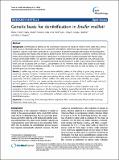Por favor, use este identificador para citar o enlazar a este item:
http://hdl.handle.net/10261/125901COMPARTIR / EXPORTAR:
 SHARE SHARE
 CORE
BASE CORE
BASE
|
|
| Visualizar otros formatos: MARC | Dublin Core | RDF | ORE | MODS | METS | DIDL | DATACITE | |

| Título: | Genetic basis for denitrification in Ensifer meliloti |
Autor: | Torres Porras, María Jesús CSIC ORCID CVN; Rubia, María I.; Coba de la Peña, Teodoro CSIC ORCID; Pueyo, José Javier CSIC ORCID ; Bedmar, Eulogio J. CSIC ORCID; Delgado Igeño, María Jesús CSIC ORCID | Palabras clave: | Cu-containing nitrite reductase Nitrate respiration Nitric oxide reductase Nitrous oxide reductase Periplasmic nitrate reductase |
Fecha de publicación: | 2-jun-2014 | Editor: | BioMed Central | Citación: | BMC Microbiology 14(1):142 (2014) | Resumen: | [Background] Denitrification is defined as the dissimilatory reduction of nitrate or nitrite to nitric oxide (NO), nitrous oxide (N2O), or dinitrogen gas (N2). N2O is a powerful atmospheric greenhouse gas and cause of ozone layer depletion. Legume crops might contribute to N2O production by providing nitrogen-rich residues for decomposition or by associating with rhizobia that are able to denitrify under free-living and symbiotic conditions. However, there are limited direct empirical data concerning N2O production by endosymbiotic bacteria associated with legume crops. Analysis of the Ensifer meliloti 1021 genome sequence revealed the presence of the napEFDABC, nirK, norECBQD and nosRZDFYLX denitrification genes. It was recently reported that this bacterium is able to grow using nitrate respiration when cells are incubated with an initial O2 concentration of 2%; however, these cells were unable to use nitrate respiration when initially incubated anoxically. The involvement of the nap, nirK, nor and nos genes in E. meliloti denitrification has not been reported. [Results] E. meliloti nap, nirK and norC mutant strains exhibited defects in their ability to grow using nitrate as a respiratory substrate. However, E meliloti nosZ was not essential for growth under these conditions. The E. meliloti napA, nirK, norC and nosZ genes encode corresponding nitrate, nitrite, nitric oxide and nitrous oxide reductases, respectively. The NorC component of the E. meliloti nitric oxide reductase has been identified as a c-type cytochrome that is 16 kDa in size. Herein, we also show that maximal expression of the E. meliloti napA, nirK, norC and nosZ genes occurred when cells were initially incubated anoxically with nitrate. [Conclusion] The E. meliloti napA, nirK, norC and nosZ genes are involved in nitrate respiration and in the expression of denitrification enzymes in this bacterium. Our findings expand the short list of rhizobia for which denitrification gene function has been demonstrated. The inability of E. meliloti to grow when cells are initially subjected to anoxic conditions is not attributable to defects in the expression of the napA, nirK, norC and nosZ denitrification genes. |
Versión del editor: | http://dx.doi.org/10.1186/1471-2180-14-142 | URI: | http://hdl.handle.net/10261/125901 | DOI: | 10.1186/1471-2180-14-142 | ISSN: | 1471-2180 |
| Aparece en las colecciones: | (EEZ) Artículos (ICA) Artículos |
Ficheros en este ítem:
| Fichero | Descripción | Tamaño | Formato | |
|---|---|---|---|---|
| 12866_2014_Article_2299.pdf | 363,69 kB | Adobe PDF |  Visualizar/Abrir |
CORE Recommender
PubMed Central
Citations
14
checked on 19-abr-2024
SCOPUSTM
Citations
30
checked on 15-abr-2024
WEB OF SCIENCETM
Citations
28
checked on 28-feb-2024
Page view(s)
318
checked on 18-abr-2024
Download(s)
226
checked on 18-abr-2024

